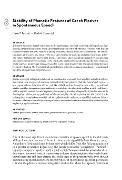Stability of Phonetic Features of Czech Plosives in Spontaneous Speech

Datum vydání
2020Publikováno v
Studie z aplikované lingvistiky / Studies in Applied Linguistics [online]Ročník / Číslo vydání
12 (2)ISBN / ISSN
ISSN: 1804-3240Informace o financování
MSM/EF/EF16_019/0000734
UK/PROGRES/Q10
Metadata
Zobrazit celý záznamKolekce
Abstrakt
This study examines speech reductions in the spontaneous Czech of six young adult speakers. Specifically, intervocalic plosives are analysed from the perspective of phonetic (articulatory, acoustic, perceptual) features, with the aim to discover these features' relative stability. Auditory analysis was used to determine the realisation types of plosives, and these types were then verified by acoustic analyses of duration, intensity range, harmonicity, and voicing profile. The results show that phonologically voiced plosives undergo reduction processes more, with semi-vocalised realisation being most frequent, while voiceless plosives are reduced less often, with fricative-like realisation being the most frequent reduction. The least stable phonetic feature of Czech plosives is thus closure, as confirmed by all the analysed acoustic parameters.
Klíčová slova
speech production, speech reductions, phonetic features, plosives, Czech
Trvalý odkaz
https://hdl.handle.net/20.500.14178/1882Licence
Licence pro užití plného textu výsledku: Creative Commons Uveďte původ-Neužívejte dílo komerčně-Nezpracovávejte 2.0 Generic




